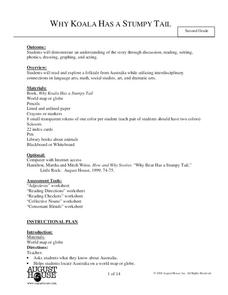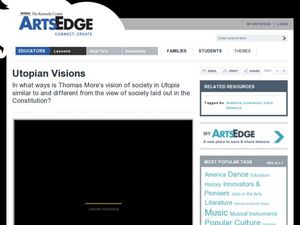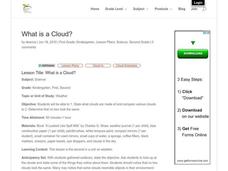Curated OER
Revolutionary War Era Research Project
Young historians interpret historical evidence presented in primary and secondary resources in this American Revolution lesson. They select topics from the time era that they are interested in researching. Additionally, they follow...
Denver Art Museum
The Poetry in Non-Events
The photograph, Nellie and her Italian Soda is viewed and discussed by the class. They are instructed to use the photograph as inspiration to write a poem about non-events, or things that are beautiful in every day life. Pupils use...
Illustrative Mathematics
Downhill
A car traveling down a steep hill is the model for this resource. The confusion comes when the elevation, E, is given in terms of distance, d. The distance, d, is the horizontal distance from E. Therefore, the equation, E = 7500 – 250d,...
Curated OER
Introduce Vocabulary: One Tiny Turle
Learners use context clues to figure out the meaning of new vocabulary words in the story, One Tiny Turtle. In this language arts lesson, students listen to the story and raise their hands when they hear the new term used in the...
Curated OER
Scenic Attractions In Four Corners
Fourth graders find and list scenic attractions in SE Utah and the Four-Corners-region. They receive direct instruction and carry out activities in cooperative group settings. They combine their findings onto one large map at the end of...
Curated OER
Scenic Attractions in Four Corners
Fourth graders find and list scenic attractions in SE Utah and the Four-Corners-region. They identify geographic characteristics of Utah and other states in the western region of the United States. They review cardinal directions and...
Curated OER
Cultural Lit. 26: Anasazi Pueblo: 1050 to 1300 A.D.
Sixth graders study Anasazi Culture through direct instruction and cooperative groups.
Curated OER
Why Koala Has a Stumpy Tail
Second graders explore Australian folktales. For this folktales lesson, 2nd graders gain knowledge about Australia and it's animals by reading books and discussion. Students find the adjectives in the book and write what they describe....
Curated OER
Diversity/Journalism - Book Making
Third graders explore Canadian culture by creating a book. In this community analysis lesson, 3rd graders identify the First Nations people of Canada and discuss the culture, language and diversity. Students create a book discussing...
Curated OER
Treaties- Grade 9
Learners discover historical and current issues regarding First Nations Treaties. In this Canadian history lesson, students read and analyze treaties made between the Canadian government and the native people of the land. Learners...
Curated OER
Utopian Visions
Students examine Sir Thomas More's Utopian vision. In this philosophy lesson, students read Utopia and determine the pros and cons of Utopian societies. Students then create and present monologues of residents of the Utopia.
Curated OER
Comparing Fiction and Nonfiction
Fifth graders compare and contrast an informational article with a fictional story. They read the story "The Contest" as a class, and discuss the different types of literature genres. Next, they complete a vocabulary worksheet and a...
Curated OER
Getting to Know You
Fifth graders identify strategies to assist in choosing a book. In this book selection lesson plan, 5th graders discuss ways to determine if a book is the right reading level or on a topic of interest. Students preview several books and...
Curated OER
Drafting
Students engage in the writing process. In this drafting lesson, students research different types of genres to find which they enjoy reading and writing. They review the drama in a story and discuss different story prompts.
Curated OER
A World of Symmetry
Students identify lines of symmetry. In this symmetry lesson, students create objects and identify their lines of symmetry. They answer questions about lines of symmetry. Students cut shapes out of cookie dough and...
Curated OER
The Planet Mars
Fifth graders gain knowledge about Mars and Earth. In this compare and contrast lesson, 5th graders use visual representations of the solar system to observe the characteristics of the planets. Students read fiction and nonfiction...
Curated OER
What is a Cloud?
Students identify what clouds are made of. In this weather science lesson, students look at clouds outside the window and draw what they see in their journals. Students read the book It Looked Like Spilled Milk and identify what clouds...
Curated OER
Poetry Writing
Students read various examples of poetry and create a poetry portfolio. In this poetry writing lesson, students work at their own pace to complete a poetry portfolio with examples of the different poetic forms demonstrated. ...
Curated OER
Daily Weather Calendar
Third graders use the internet to record the daily weather conditions. Using symbols, they take the information they gathered and create an easy to read chart. They share their charts with the class to end the lesson.
Curated OER
We Write to Read
Students are introduced to cursive handwriting as a symbolic language system. In this cursive handwriting lesson, students apply the Peterson sequence approach and practice gross motor patterning and action word rhythm. Students...
Curated OER
Following Instructions Using BBC Skillswise
In this computer worksheet, students complete a BBC Skillswise task. Students complete 9 steps that include finding the home page and locating different activities.
Curated OER
St. Patrick’s Day
Combine math, creative writing, and leprechauns in a fun St. Patrick's Day activity! Using a bag of gold coins and marshmallows, kids write a math story about a leprechaun that includes a multi-step equation to solve.
California Education Partners
Letter From Birmingham Jail
To demonstrate their ability to comprehend complex text, ninth graders are asked to craft an essay in which they use evidence drawn from "Letter From Birmingham Jail" to analyze how Martin Luther King, Jr. uses rhetorical devices...
Novelinks
Tuck Everlasting: Bio-Poem
Learn about the characters of Natalie Babbitt's Tuck Everlasting with a character biopoem. Readers fill in a poem format to detail the character traits of Winnie, Jesse, Miles, and Mae, and share their finished poems...























